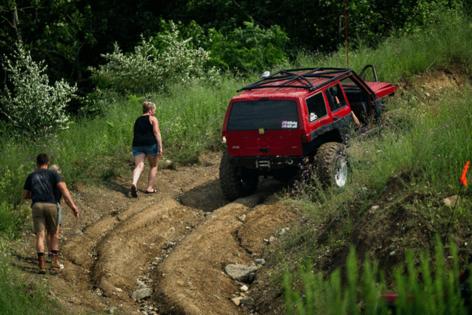'Trying to be Jeeps': Why automakers are leaning into off-roading trims
Published in Automotive News
Brawny SUVs like the Jeep Wrangler, Toyota Land Cruiser and Ford Bronco were once among a handful of vehicles that came ready to tackle mud, rocks and sand as soon as they left the factory.
Now, carmakers are increasingly adding many of the same stock off-roading features to all types of models: mild-mannered crossovers, three-row family movers and pickups once geared toward the farm or job site.
The adventure trims have tough-sounding monikers like Sasquatch, TrailSport, X-Pro, Tremor and Wilderness. And they often feature a raised ride height and gobs of black exterior plastic that scream muscle.
“They’re trying to be Jeeps,” said Bill Golling, president of a group of Detroit-area dealerships.
Analysts said the rugged-looking models generally sell well and command premium prices. The trend aligns with surging popularity in outdoor pursuits like camping, hiking, skiing and overlanding. Last year, the Outdoor Industry Association reported 32 million more people participated in some kind of outdoor activity than they did in 2019, prior to the pandemic.
But it’s not all about getting out into the woods. Dealers said plenty of buyers just like the appearance of blacked-out plastic grilles, beefy all-terrain tires, skid plates and roof racks — even if they never plan to leave the asphalt. Such features can help someone project a story that says, “I’m that person who likes the outdoors, I’m that sporty person,” said Sean Hogan, vice president of Sierra Auto Group in Southern California, which sells brands including Subaru, Ineos, Jeep and Chevrolet.
"You can do no wrong by adding a lift kit, some wheels, and saying something is going to go off-road,” said Ivan Drury, director of insights at vehicle information site Edmunds.com Inc. “It's just sales, outright sales.”
Drury himself was drawn to the burly looks of one such model: His daily driver is a Subaru Crosstrek Wilderness.
“Everyone doesn’t necessarily go off-road,” said Phil Zak, global executive design director for Chevrolet. “But I guarantee everyone that shops at Lululemon doesn’t do yoga.”
CR-V hits the trail
An Edmunds review of five SUVs and crossovers for 2025 found that their off-road variants made up roughly one in every six sales on average. Those five rugged trims have sticker prices thousands of dollars higher than the base models, and they aren’t usually needing heavy discounts to sell.
As a result, brands keep adding new off-road versions to their lineups — even on vehicles traditionally more associated with treks to the grocery store or soccer practice.
Take the Honda CR-V, which recently added a TrailSport trim; the Nissan Rogue, which can be had with a Rock Creek offroad package; or the Toyota RAV4, with a Woodland edition. Hyundai and Kia have jumped in with the XRT and X-Pro trim lines, respectively, while Mazda and Volkswagen have also recently introduced rugged SUV packages.
"Every manufacturer sees that these are the desirable trims," said Hogan, who noted the trend started ramping up after the pandemic and aligns with customers wanting to add some of their own outdoor accessories, like rooftop tents.
Detroit’s automakers also have cashed in across their SUV and truck lineups, including on three-row family SUVs. The Ford Expedition's Tremor trim makes up about 15% of that model's sales, for example, and the Chevrolet Traverse Z71 accounts for 19% of that model's transactions.
At Champion-Hargreaves Chevrolet in Royal Oak, Michigan, dealer Walt Tutak said the off-road pickup trims are much more popular than the SUV versions, making up close to a third of his overall pickup sales. Customers really seem to like the "husky, bulky look," he said.
Even Jeep — which already touts 4x4 capabilities on every SUV — offers several variants that come loaded with even more off-roading extras, like tow hooks, skid plates, tuned suspensions and special low-range gearing.
'It gives that vibe'
The off-road-centric Jeep Wrangler continues to be among the brand’s best sellers. The boxy SUV showed other carmakers there is a large and loyal audience for off-roading models — even ones that aren’t the most practical daily on-road drivers.
Sales of the Wrangler, which last saw a full redesign for 2018, were up 23% in the second quarter of this year.
"It’s highly profitable, and Jeep had it to themselves for far too long before Ford stepped in and Toyota was coming in," said Sam Fiorani, vice president of global vehicle forecasting at AutoForecast Solutions LLC. "There are other brands that are looking to appeal to the same customers.”
Joseph Yoon, an Edmunds consumer insights analyst, said even as the off-road competition heats up, the Wrangler still maintains a broad appeal.
“Off-road guys like it because it can actually off-road,” he said. “It’s very hardy and rough-and-tumble. People in cities like it because it gives that vibe. You can take the doors off, you can take the roof off, you can take everything off and drive around.”
Jeep recognized the opportunity for profit from the outdoorsy market early on with the 1987 Wrangler. SUVs gained popularity in the 1980s and 1990s as a bridge between pickups primarily used for farming, and suburbanites toting kids in minivans who aspired to the American ideal of rugged individualism.
Other automakers focused on tweaking truck designs into SUVs with third rows spacious and comfortable enough for daily office commutes and rides to school, believing the market among true outdoor enthusiasts to be too small. But Jeep leaned into its roots as maker of the Willys MB, an essential lightweight 4x4 vehicle for Allied forces during World War II.
Then-Chrysler President Bob Lutz highlighted Jeep’s tough reputation by smashing the 1993 Grand Cherokee through a plate glass window and into Cobo Center (now Huntington Place) for its debut at the North American International Auto Show in 1992.
Similar to some Jeep drivers hoping to look more adventurous than they are, the stunt was much less dangerous than it appeared. Engineers worked for weeks to rig the glass with tiny explosives to ensure it shattered spectacularly, according to reporting by longtime auto writer Paul Ingrassia.
'Mall crawlers' or real off-roaders?
Alex Ritzema has a name for off-road vehicle drivers who are faking it: “mall crawlers.”
The 55-year-old Michiganian bought a used 2013 Toyota Tacoma with an off-road package in 2018 with the dream of someday taking it four-wheeling. He finally saved up enough money to raise the truck’s clearance for off-roading after seven years of camping, hauling DIY materials and rescuing cars from snow banks during brutal winters in his hometown of Holland.
He described scaling steep hills at an off-road park this spring — while his wife gripped the inside of the truck with white knuckles — as a “visceral experience.”
“You feel like you’re in a rollercoaster, but in a rollercoaster you can’t control everything,” Ritzema said. “With a truck, you’re in charge. You’re responsible. And so it’s a big test of the vehicle and of your own skills.”
Tom Zielinski, president of Motorsports events company Z Performance, is trying to bridge the gap between drivers and their performance trucks and SUVs. Zielinkski manages events at Oakland County's Holly Oaks ORV Park, including an off-roading 101 class to help curious owners safely unlock the full potential of their vehicles.
He said some sporty truck and SUV drivers use their vehicles to commute to work and worry about damaging their main mode of transportation.
“There’s definitely a crowd that has very specialized vehicles, and you would easily be able to identify them when you saw them,” said Zielinski, who drives a 2021 Jeep Gladiator with 37-inch wheels and more than 150,000 miles on it. “But the vast majority of people that come out to play, particularly those in the Wrangler (or) Bronco category of vehicles, are using their vehicles as their daily driver to get to work and to the store and wherever else.”
His goal is to increase the confidence of sport-vehicle owners who have little or no experience off-roading.
“It’s intimidating, and then they look at the hills, and they’re like, no way. There’s no chance I’m doing that,” Zielinski said. “And then you show them how and they’re like, 'I never thought my vehicle could do that. I never thought I could do that.' So there’s a definite sense of empowerment in all of this as well.”
Robert Mauro is a "Subaru ambassador" who drives a 2019 Subaru Ascent with various off-roading modifications and also moderates a popular Facebook page for Subaru Wilderness owners.
The 56-year-old from Long Island, New York, said the off-road Subaru trim has surged in popularity since it came out in 2022 on the Outback model. The Wilderness packages — now also available on the Crosstrek and Forester models — allow drivers to access that remote trail or campsite that's 10 or 20 miles into the desert without the need for any extra modifications, he said.
"They're selling like crazy," said Mauro, who in recent days was on his own Subaru off-roading adventure with friends around the West, a tour that also served as a fundraiser for the National Park Foundation.
Golling, the Detroit-area retailer who sells Toyota, Kia, GMC, Jeep and other brands, said off-road trims started gaining popularity around five years ago. While everyone seems to love the rugged look right now, the dealer questioned how many of these SUVs and trucks actually touch dirt once they leave his showroom.
"Most four-wheel drives," he said, "only go off-road when you miss the driveway."
©2025 www.detroitnews.com. Visit at detroitnews.com. Distributed by Tribune Content Agency, LLC.








Comments